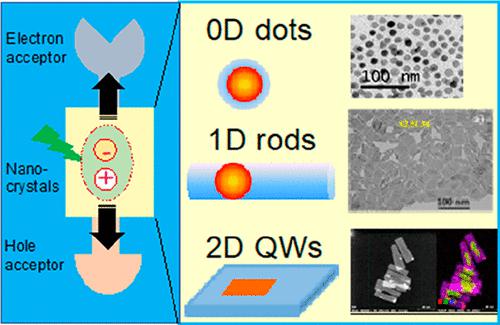当前位置:
X-MOL 学术
›
Chem. Rev.
›
论文详情
Our official English website, www.x-mol.net, welcomes your feedback! (Note: you will need to create a separate account there.)
Charge Transfer from Quantum-Confined 0D, 1D, and 2D Nanocrystals
Chemical Reviews ( IF 62.1 ) Pub Date : 2024-04-17 , DOI: 10.1021/acs.chemrev.3c00742 Qiuyang Li 1 , Kaifeng Wu 2, 3 , Haiming Zhu 4 , Ye Yang 5 , Sheng He 6 , Tianquan Lian 6
Chemical Reviews ( IF 62.1 ) Pub Date : 2024-04-17 , DOI: 10.1021/acs.chemrev.3c00742 Qiuyang Li 1 , Kaifeng Wu 2, 3 , Haiming Zhu 4 , Ye Yang 5 , Sheng He 6 , Tianquan Lian 6
Affiliation

|
The properties of colloidal quantum-confined semiconductor nanocrystals (NCs), including zero-dimensional (0D) quantum dots, 1D nanorods, 2D nanoplatelets, and their heterostructures, can be tuned through their size, dimensionality, and material composition. In their photovoltaic and photocatalytic applications, a key step is to generate spatially separated and long-lived electrons and holes by interfacial charge transfer. These charge transfer properties have been extensively studied recently, which is the subject of this Review. The Review starts with a summary of the electronic structure and optical properties of 0D–2D nanocrystals, followed by the advances in wave function engineering, a novel way to control the spatial distribution of electrons and holes, through their size, dimension, and composition. It discusses the dependence of NC charge transfer on various parameters and the development of the Auger-assisted charge transfer model. Recent advances in understanding multiple exciton generation, decay, and dissociation are also discussed, with an emphasis on multiple carrier transfer. Finally, the applications of nanocrystal-based systems for photocatalysis are reviewed, focusing on the photodriven charge separation and recombination processes that dictate the function and performance of these materials. The Review ends with a summary and outlook of key remaining challenges and promising future directions in the field.
中文翻译:

量子限制 0D、1D 和 2D 纳米晶体的电荷转移
胶体量子限制半导体纳米晶体 (NC) 的特性,包括零维 (0D) 量子点、1D 纳米棒、2D 纳米片及其异质结构,可以通过其尺寸、维度和材料成分进行调节。在光伏和光催化应用中,关键步骤是通过界面电荷转移产生空间分离且长寿命的电子和空穴。这些电荷转移特性最近得到了广泛的研究,这是本综述的主题。该综述首先总结了 0D-2D 纳米晶体的电子结构和光学特性,然后介绍了波函数工程的进展,这是一种通过尺寸、尺寸和成分控制电子和空穴空间分布的新方法。它讨论了数控电荷转移对各种参数的依赖性以及俄歇辅助电荷转移模型的发展。还讨论了理解多激子产生、衰变和解离的最新进展,重点是多载流子转移。最后,回顾了基于纳米晶体的光催化系统的应用,重点关注决定这些材料功能和性能的光驱动电荷分离和重组过程。审查最后总结和展望了该领域仍存在的主要挑战和有希望的未来方向。
更新日期:2024-04-17
中文翻译:

量子限制 0D、1D 和 2D 纳米晶体的电荷转移
胶体量子限制半导体纳米晶体 (NC) 的特性,包括零维 (0D) 量子点、1D 纳米棒、2D 纳米片及其异质结构,可以通过其尺寸、维度和材料成分进行调节。在光伏和光催化应用中,关键步骤是通过界面电荷转移产生空间分离且长寿命的电子和空穴。这些电荷转移特性最近得到了广泛的研究,这是本综述的主题。该综述首先总结了 0D-2D 纳米晶体的电子结构和光学特性,然后介绍了波函数工程的进展,这是一种通过尺寸、尺寸和成分控制电子和空穴空间分布的新方法。它讨论了数控电荷转移对各种参数的依赖性以及俄歇辅助电荷转移模型的发展。还讨论了理解多激子产生、衰变和解离的最新进展,重点是多载流子转移。最后,回顾了基于纳米晶体的光催化系统的应用,重点关注决定这些材料功能和性能的光驱动电荷分离和重组过程。审查最后总结和展望了该领域仍存在的主要挑战和有希望的未来方向。



























 京公网安备 11010802027423号
京公网安备 11010802027423号